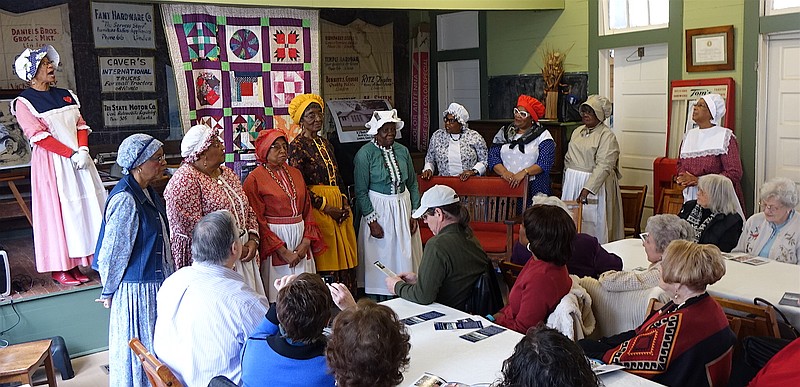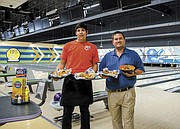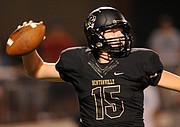The Pleasant Hill quilters are mostly educators. Several are former schoolteachers.
So when they present their program on the "Secret Code Quilts of the Underground Railroad," they seem to delight in explaining the mystery behind this old practice.
Each one speaks proudly in strong and clear voice about how the slaves escaped north during the Civil War era, all the while looking for quilts displayed with secret messages about how to proceed or where to find safe houses and trustworthy people.Their audiences join in and get "wrapped' up in this quilt story. Even the song lyrics from slavery days had secret messages. In their sparkling clean, starched bonnets and aprons, which they've made themselves, the quilters sing 14 of these, including the well-known "Wade in the Water."
The quilters said while the slave-owner would hear the slaves in the fields singing these songs and know they were at work, the singers knew with one another that they were singing about escape.
The quilting ladies tell of the 10 primary patterns used in quilts that communicated messages. A house, river, path, weather to watch for or places to hide might be safely indicated.
They enjoy telling about Harriet Tubman, famous for having conducted 300 slaves to freedom along the underground railroad.
The underground railroad was an imaginative construct from the mind of a slave, Pleasant Grove leader Flo Stevenson explained in her remarks to the Texarkana chapter of the Daughters of the American Revolution last Thursday at the Pleasant Hill Rosenwald School.
"This escape method got its name from a slave, who had been asked how another slave had jumped into the Ohio River, swam across to freedom and put a light on the distant shore for others to follow," she said.
"When this slave was asked what happened, he said it was an underground railroad that stopped, picked up the slave and took him across. The imaginative idea stuck,"The Pleasant Hill Quilters act and tell the story of the underground quilt code all around the region and have 12 such performances scheduled this coming year, Stevenson said.
"We raise funds this way to support this school as a community center, but mainly sew the sampler quilts and have them for sale," she said.
"We only do one type, that's the sampler type we're showing you today. We get $250 for the full, $300 to $350 for the queen and $400 for the king size. You pay half down and give us a year to make it, although we do it in about six months.
"We're most all retired teachers, don't you see, and still are on school time. We don't work in summers," she concluded to laughter from the room.
The Pleasant Grove School makes for a perfect place to present the underground railroad's dramatic story, sew quilts and invite guests to attend as if in a theater. The atmosphere is warm and friendly, a history lesson is being lived and a former school is now a community center, which is being enjoyed as a source of community pride.



